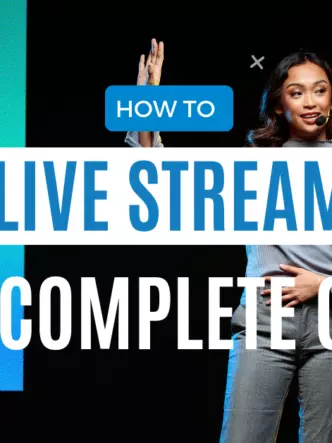The traditional television industry is going through changes as the increasing popularity of new ways of consuming content disrupts the market. Newer non-linear TV technology has not resulted in linear TV becoming obsolete.
It continues to play a role, particularly when it comes to viewing events like live sports. However, non-linear viewing is constantly gaining in popularity. Viewing habits and preferences tend to vary by age group, with older participants continuing to prefer linear consumption and younger viewers favoring non-linear viewing.
What is linear TV?
Linear TV offers viewers access to content via subscription to cable or satellite services or through over-the-air broadcasts. The term linear refers to the way in which viewers consume the content. They can only watch programs according to a broadcaster programming schedule. If they want to watch their favorite content, they have to tune in to a specific TV channel at a specific time. This is the broadcasting style traditional television and radio stations have used for years.
What is OTT?
Over-the-top television (OTT) refers to TV content delivered via the internet in a live streaming format. It is possible to access content without the involvement of cable or satellite service providers. Anyone with an internet connection and a compatible hardware device can stream content to a TV or any internet-connected device.
Some examples of OTT devices include Apple TV and Amazon Fire TV. Plugging these devices into the HDMI port of the TV streams the relevant content from popular OTT providers like Netflix, Hulu, and Amazon Prime. Smartphones and tablets can download OTT apps and this allows streaming on-the-go.
Why is OTT so attractive?
OTT services give viewers full control over their consumption and access to high-quality content, often in HD and usually in the form of movies and TV shows. They can literally customize their viewing experience and watch whatever they want to watch from available titles. This gives them the freedom to be in the driving seat and go straight to what they want to watch.
Viewers can not only watch from anywhere at any time but on any device. This is very valuable for viewers who can’t afford to watch television shows at a fixed time in a particular location. It is also possible to pause when watching shows and continue viewing them later if necessary.
There are predictions that 25% of households in the U.S. will cancel their cable subscriptions by 2022. The OTT market is expected to reach two hundred billion before 2025, making it one of the world’s most significant sources of entertainment. It has also gained in popularity since the start of the COVID-19 pandemic, with many people relying on OTT services to pass the time during lockdowns.
Why is linear TV not obsolete yet?
If OTT services are so popular, why is it that linear TV isn’t obsolete? Linear TV is still popular when it comes to live events, such as sports or live game shows where viewers can cast votes. Streaming services are fighting for a share of live sports but technical limitations such as higher latency means linear TV is still dominant in this area.
Linear TV has long-standing expertise and the infrastructure and the resources to broadcast global news and large events.
The willingness of major industry players to adapt to new technology and innovation will play a role in what happens in the future. Some major players have launched their own OTT services, such as NBC’s Peacock, Disney Plus, and HBO.
Does linear TV still have a future?
Other companies have taken linear TV to the next level by embracing Cloud TV. This allows them to leverage cloud-based infrastructure to deliver their services and OTT services. In this way, they can maintain the robust nature and scalability of linear TV and yet also benefit from access to the same technology as OTT, which makes personalization and advanced audience targeting possible. Cloud TV could just be the future of linear TV as it combines the best of linear TV and OTT.
How do age differences influence use?
Linear TV differs from OTT in that it is for all age groups and all audiences, whereas the primary use of OTT is by young adults between the ages of about 18 to 29. They use their mobile phones and laptops more than TVs for entertainment and most of them rely entirely on OTT platforms.
Many millennials and Generation Y viewers have cut the cord to linear TV services as they prefer uninterrupted content on demand and they can get a great variety of content at a better price. The age group between 30 and 45 don’t seem to mind using linear and OTT TV and frequently use both.
Older consumers tend to value the familiar, effortless viewing experience that comes with having scheduled content served up for them. Operating a traditional TV is easier for those who aren’t tech-savvy and most people of about 45 and older still prefer traditional TV. They are often overwhelmed by the choices of OTT and find it difficult to stream shows, use streaming sticks, navigate menus, etc. They still tend to associate TV sets with linear viewing and with the shared, social experience of watching TV with other family members.
The OTT advertising advantage
Many people who watch linear TV express frustration at the number of adverts and will often get up to make tea or do something else while an ad is playing. They find advertising so intrusive because they generally have little interest in the ads that are shown. Advertisers are recognizing the need for more creative, data-driven, target advertising experiences and the OTT environment gives them this opportunity.
OTT advertising provides a range of advantages over linear TV advertising. Given that it comes via a digital stream, OTT offers granular ad-targeting capabilities. It arms advertisers with some powerful tools to target consumers and use analytics at lower costs. This is creating better experiences for advertisers and for consumers than advertising on linear TV.
Better targeting: The delivery of OTT content over the internet to connected TVs and devices means advertisers can target customers according to factors like their needs, interests, and location. Linear TV advertising only uses ratings and the time of day to target consumers. OTT advertisers can serve ads to specific people according to their behavior just as they do with video advertising.
Advertising rates based on views: Advertising rates on linear TV are based on ratings. These ratings aren’t always accurate as they reflect projections and estimates of the number of viewers expected to watch at a certain time. OTT requires advertisers to pay only for actual ad views/ impressions.
Real-time reports and analytics: OTT offers ad managers the opportunity to track ad performance using real-time reports so they can optimize their ads accordingly.
OTT viewing combines the premium content of traditional TV with digital advertising power. It creates a compelling environment in which viewers can engage with content along with an advertiser’s message.
As consumers continue to embrace OTT, it is only a matter of time before advertisers start spending more money on advertising. Targeting the right audiences and measuring the impact of OTT advertising will be critical for success.
The bottom line
In the past, television was broadcast to a mass audience via a few channels and followed a predetermined schedule. Transformation of technology and levels of connectivity have also led to a change in media habits and viewing is no longer limited to traditional linear broadcasts.
The world is no longer consuming TV as a family, once a week and primarily on television. Now, most people are streaming content on mobile phones, computers and TVs. Viewers can decide what, when and where to watch, which is shaping a new mindset and big broadcast networks need to consider different ways to market and deliver.









